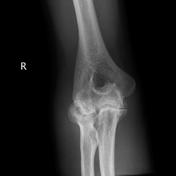Hemophilia
Updates to Article Attributes
Haemophilia is an inherited bleeding disorder which is X-linked recessive and therefore occurs almost exclusively in males. There are two subtypes - haemophilia A (80%) and haemophilia B (20%).
Epidemiology
The incidence of haemophilia A is around 1 in 5000 male births, and the incidence of haemophilia B is around 1 in 25,000-30,000 male births.
Clinical presentation
Most patients present with bleeding during the neonatal period or with bleeding / large haematoma following minor trauma as a toddler. Haemophilia A and B are difficult to delineate clinically 6.
Pathology
Haemophilia is an inheritable X-linked recessive disease 6, with 70% considered familial and 30% considered sporadic 8. It occurs when there is a mutation of the F8 or F9 gene, causing haemophilia A or B respectively, on the long-arm of the X-chromosome 7.
Haemophilia A
- 80% of cases
- F8 gene mutation
- coagulation factor VIII deficiency or absence
- one-third have no family history
Haemophilia B
- a.k.a. Christmas disease
- 20% of cases
- F9 gene mutation
- coagulation factor IX deficiency or absence
- ~70% of patients have the severe form of the disease characterised by spontaneous haemorrhage or haemorrhage following minor trauma 1
Associations
Transfusion-related diseases associated with the treatment of haemophilia include:
Radiographic features
The hallmark of the disease is haemorrhage, particularly into joints and/or soft-tissue, with three mainseveral radiological consequences:
- haemophilic arthropathy occurring in almost all individuals
- haemophilic pseudotumour occurring in ~2%
- soft tissue haematoma formation may lead to contractures 3
- serious life-threatening haemorrhage (intracranial, thoracic, abdominal)
Treatment and prognosis
Treatment depends on the type, general severity and current clinical state. Factor VIII and IX blood product concentrate and recombinant factors can be used.
Prognosis depends on the severity and on the presence or absence of transfusion-related disease. HIV is a leading cause of death. Life expectancy in those without HIV is ~62 years 2.
- ~15 times increased risk death from intracranial haemorrhage (~1/3 of all deaths)
- ~50 times increased risk death from non-intracranial haemorrhage
See also
-</ul><h4>Radiographic features</h4><p>The hallmark of the disease is haemorrhage, particularly into joints and/or soft-tissue, with three main radiological consequences:</p><ul>- +</ul><h4>Radiographic features</h4><p>The hallmark of the disease is haemorrhage, particularly into joints and/or soft-tissue, with several radiological consequences:</p><ul>
Image 2 X-ray (Frontal) ( update )

Image 3 X-ray (Lateral) ( update )

Image 4 X-ray ( update )

Image 5 X-ray ( update )

Image 6 X-ray (Frontal) ( update )

Image 7 X-ray (Frontal) ( create )








 Unable to process the form. Check for errors and try again.
Unable to process the form. Check for errors and try again.